A press release announcing Claire Greenshaw’s The World Has A You Shaped Hole In It at the Khyber Center For The Arts featured a photograph of a woman with a dog harnessed to her chest, walking across a gravelly plateau overlooking an arid mountain range under blue skies. The photograph is entitled Mother Nature—perhaps, one supposes, because the categories of “nature” and “artifice” are exploded, with the “Mother” referring to the human bringing a mutt into the wilderness in a baby carrier—one could also be forgiven for thinking that the image was a document of some kind of performance piece, mistaking the woman in the shot for Greenshaw herself. On the contrary, Greenshaw explains that she captured the pair of figures by chance when she happened to be taking some vacation pictures. Nonetheless, the confusion had already been made: I became interested in imagining the photograph as a photo-documentative one, and set out to interpret how, as the introductory image for the exhibition, Mother Nature reorders the viewer’s expectations of Greenshaw’s diverse offering of drawing, sculpture and photography.
Flip through any recent art magazine or contemporary art website and one finds that photographic images far outflank their drawn or painted counterparts. The conflict between manual versus photographic means of rendering the naturalistic picture is over a century old, of course, but since Conceptualism and the advent of installation art, the photographic aesthetic has been seen to dominate in a second way. The question for artists working in two-dimensional media becomes whether their art will eventually take the form of photo-reproduction or photo-documentation, and, seeing as these days even traditional canvases are often captured from the “installation view” within the gallery, it is clear that the latter form has prevailed. Boris Groys contended that art documentation is by definition not art, and by referring to an artwork only confirms art’s absence;1 in practice, however, it can be said that the photo-documentative artifact actually professes to more, not less: it is both the image itself, and the event captured within the image. As photo-documentation, Mother Nature would stake its claim to doubled instances of art—the picture and the “performance.” By contrast, as photo-reproduction it could only be a picture, and it is evident that contemporary art deems this increasingly inadequate, and an anachronism.
The larger portion of Greenshaw’s recent work are coloured pencil renderings of folded, torn or otherwise castaway scraps of paper (grocery lists, scribbled notes). They are drawings, after all, and would have apparently little to do with the above distinctions, except the photo-documentative sensibility broached by Mother Nature finds its equivalent in the restlessness expressed in these pictures-within-pictures in their resistance to being restricted to their face values. The first of four drawings in the exhibition shows a squarish piece of paper on which is printed a photograph of a silhouetted dancer in mid-arabesque along the seashore. Yet its title, Paper Boat, refers to the pattern of creases that mark the specimen—as if to insist that, as a drawing of an unfolded origami boat, its pictorial content is incidental. In Sinkhole, the depicted object appears to be a fragment cut roughly into the shape of a circle and placed against a white ground. Like an Escher-esque cube, however, the image “inverts,” and suddenly we are viewing through a cutout hole. Not unlike photo-documentative images, the seemingly innocuous inclusion of a frame ends up emphasizing the frame’s existence, the contextual and temporal implications of which become integral to the picture. Finally, whereas Greenshaw treated the photographic content in Paper Boat indiscriminately as tonal value on a surface, the mark-making in Sinkhole corresponds to the swirling volume and motion of the pictorial whirlpool. We are no longer sure if we are looking at a rendering of a photograph, or a drawing of a sinkhole.
Occupying the rightmost wall of the gallery is A Million Million, a 1.2 x 1.5 m photograph of a scattering of finely-crushed breadcrumbs over a black surface. The nebulous illusion of deep space that results, impressive in its own right, is interrupted by origami folds in the actual substrate, and a seemingly extraneous border that retains the printer’s record of the print job. Both disruptions act in service of the larger point that Greenshaw wants to make, which is not so much that the cosmic dust reveals itself to be specks of bread upon closer inspection, but rather that no matter how convincing the space imagery may be, it’s still a picture on a piece of paper, and not the real thing. The means of depiction cannot give us the boundless universe, but one that is utterly contained by the two additional frames of reference: one that reminds us of the materiality of the picture, and the other that marks it as a product of digital image-making technologies.
The artist plays with illusions because they, by definition, have multiple meanings—each trick of trompe-l’œil occupies the meeting point between what it mimics, and how. It is a clever touch, then, that Greenshaw placed two small sculptures in the gallery space surreptitiously defining the distance, at about two meters, at which the illusionistic success of the pictures on the wall begins to break down (the more curious of the two is Bumpwatch, a painted bronze potato; its title may be a double entendre—a colloquialism for being on the lookout for celebrity pregnancies, as well as a literal caution to mind your step). The sculptures thus function as boundaries or hinges, reminding us to occupy the other vantage points from which we can view her work.
Greenshaw would likely admit that Mother Nature is, at least aesthetically, not very representative of this body of work (it’s given an appropriately wide berth in its own corner of the gallery). In light of the various acts of play that constitute the exhibition, I suspect that she would not be displeased to find that, as a promotional image, the particular photograph deceives, taking on the significations of photo-documentation that then permeate the whole of the exhibition. Rearticulated through this effect, every piece is highlighted for the trait that they share with photo-documentative artifacts. Like snapshots of ephemeral performances and land art pieces, or installation shots which end up being re-presented in their own installative environments, Greenshaw captures in her work exemplary paradoxes.
Notes:
1. Boris Groys, Art Power (Cambridge: MIT Press, 2013): 49, 53.
- Claire Greenshaw, “Sinkhole” (detail), coloured pencil on paper, 2014

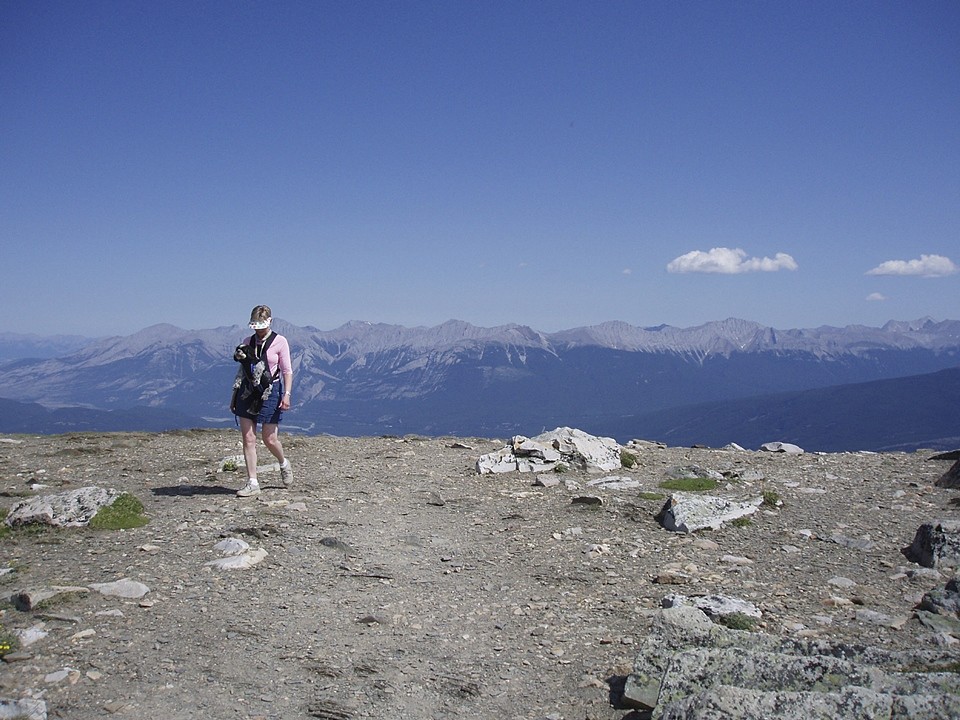
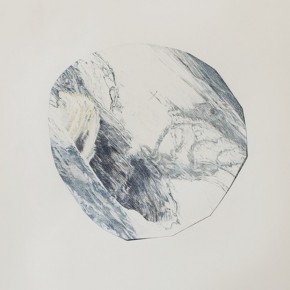
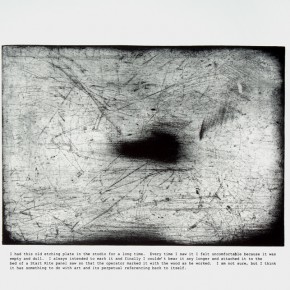
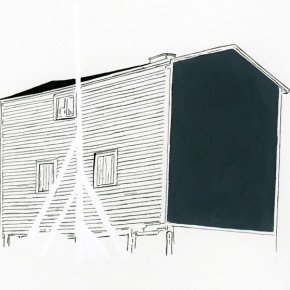
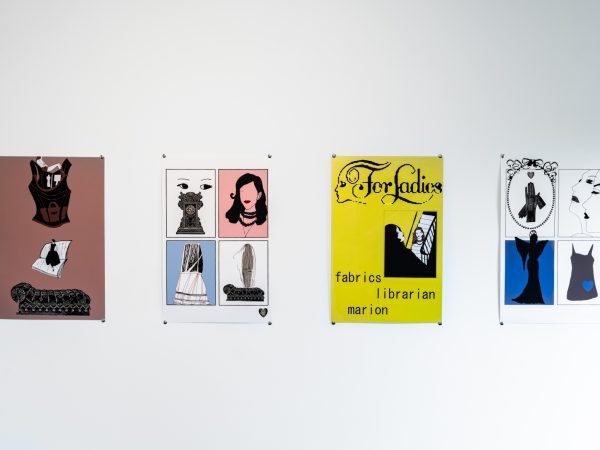
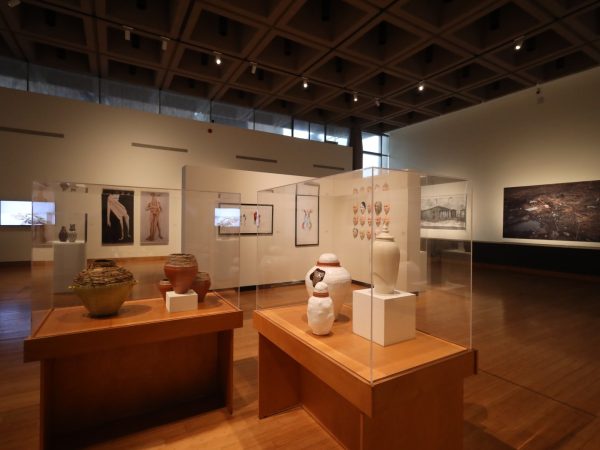











nice work, congrats Claire!